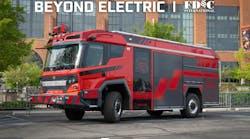In the April issue of Firehouse, the thermal imaging training article addressed TI usage with rapid intervention teams. Once departments commit to deploying TIs with their RITs, they must identify how the tool will be carried by the team. This is an important decision that requires significant trial-and-error, as well as customization to individual systems and situations.
Most departments have recognized that a RIT must consist of at least three firefighters. Some fire departments are blessed with more manpower than others, and may be able to assign an entire 6-man truck or squad company as RIT. Others might use an engine, or even a combination of companies, to establish the RIT. The RIT should have an officer; some areas actually assign a chief to act as RIT Sector should deployment be necessary. Some departments are splitting their RITs into a search team and a rescue team. In short, there are a number of ways to form a RIT.
There are several advantages to placing the TI with different RIT members. Consider placing the TI with:
- The lead firefighter in the RIT. He will be able to guide the team more quickly through the structure and possibly identify the firefighter in need earlier. Be aware that the "lead man" role may result in one member advancing faster than the rest of the team. This can also foster over-reliance on the TI, so members must be careful to maintain orientation in the structure through other means.
As with many other operations in the fire service, there is not an easy answer to, "who carries the TI?" It is important that you try a number of combinations with your RIT system to see which method is most comfortable and most likely to succeed in your operations.
Also consider what companies actually carry TIs. For example, if the TIs are assigned to truck companies, but you always use engines or squads as the RITs, then how will the RIT acquire a TI? If your TIs are on the squads, and your RIT system calls for the fourth arriving company to be the RIT, how does the second truck get a TI? Does the squad give up its TI, or do you adjust the system?
Take the time now to consider TI deployment during RIT operations. Ensure that the RIT system and your TI deployment and assignments are coordinated; make any adjustments needed. By taking this time now, you can avoid dealing with incompatible demands during an actual RIT deployment.
Hopefully, you will never have to deploy your RIT. But if you do, make sure it has a solid, tested plan on using TIs during the incident.
Use your TI often, wisely and safely.
Jonathan Bastian is a Thermal Imaging Specialist for Bullard. He is certified as a thermal imaging instructor by the Law Enforcement Thermographers' Association (LETA). He is also the author of the FD Training Network "FireNotes" book, Thermal Imaging for the Fire Service. Bastian served 12 years on the North Park, IL, Fire Department, including the last three as a captain. He has taught classes on thermal imaging, rapid intervention teams and search and rescue operations. He is currently a police officer in Lexington, Kentucky. If you have questions about thermal imaging, please send them to [email protected].





